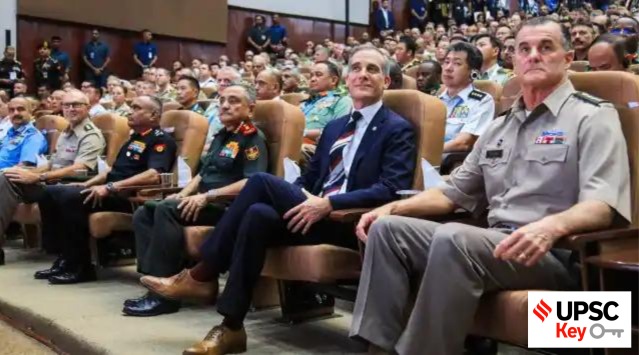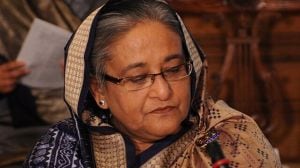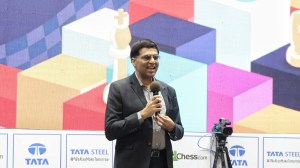Priya Kumari Shukla is a Senior Copy Editor in the Indian Express (digital). She contributes to the UPSC Section of Indian Express (digital) and started niche initiatives such as UPSC Key, UPSC Ethics Simplified, and The 360° UPSC Debate. The UPSC Key aims to assist students and aspirants in their preparation for the Civil Services and other competitive examinations. It provides valuable guidance on effective strategies for reading and comprehending newspaper content. The 360° UPSC Debate tackles a topic from all perspectives after sorting through various publications. The chosen framework for the discussion is structured in a manner that encompasses both the arguments in favour and against the topic, ensuring comprehensive coverage of many perspectives. Prior to her involvement with the Indian Express, she had affiliations with a non-governmental organisation (NGO) as well as several coaching and edutech enterprises. In her prior professional experience, she was responsible for creating and refining material in various domains, including article composition and voiceover video production. She has written in-house books on many subjects, including modern India, ancient Indian history, internal security, international relations, and the Indian economy. She has more than eight years of expertise in the field of content writing. Priya holds a Master's degree in Electronic Science from the University of Pune as well as an Executive Programme in Public Policy and Management (EPPPM) from the esteemed Indian Institute of Management Calcutta, widely recognised as one of the most prestigious business schools in India. She is also an alumni of Jamia Milia Islamia University Residential Coaching Academy (RCA). Priya has made diligent efforts to engage in research endeavours, acquiring the necessary skills to effectively examine and synthesise facts and empirical evidence prior to presenting their perspective. Priya demonstrates a strong passion for reading, particularly in the genres of classical Hindi, English, Maithili, and Marathi novels and novellas. Additionally, she possessed the distinction of being a cricket player at the national level. Qualification, Degrees / other achievements: Master's degree in Electronic Science from University of Pune and Executive Programme in Public Policy and Management (EPPPM) from Indian Institute of Management Calcutta ... Read More
UPSC Key—27 September, 2023: Armed Forces (Special Powers) Act, Copyright Infringement and Indo-Pacific Armies Chiefs’ Conference
Exclusive for Subscribers from Monday to Friday: Have you ever thought how The Cauvery water-sharing issue between Karnataka and Tamil Nadu and Cauvery Water Management Authority are relevant to the UPSC Exam? What significance do topics like passing off, disturbed area, compulsorily retirement by the government and South Caucasus have for both the preliminary and main exams? You can learn more by reading the Indian Express UPSC Key for September 27, 2023.
 UPSC Key September 2023: Here's what you should be reading from the September 27, 2023 edition of The Indian Express
UPSC Key September 2023: Here's what you should be reading from the September 27, 2023 edition of The Indian Express
Important topics and their relevance in UPSC CSE exam for September 27, 2023. If you missed the September 26, 2023 UPSC CSE exam key from the Indian Express, read it here
THE WORLD
At least 125 killed in fuel station explosion as Armenians flee Nagorno-Karabakh fighting
Syllabus:
Preliminary Examination: Current events of national and international importance.
Mains Examination: General Studies II: Effect of policies and politics of developed and developing countries on India’s interests.
Key Points to Ponder:
• What’s the ongoing story- Separatist authorities in Nagorno-Karabakh said Tuesday that at least 20 people were killed and nearly 300 others injured by an explosion at a crowded gas station as thousands of people rushed to cross into Armenia. More than 13,500 people — about 12% of the region’s population — have fled across the border since Azerbaijan’s swift military operation to fully reclaim the region after three decades of separatist rule, Armenia’s government said Tuesday morning.
• What is the present situation in Nagorno-Karabakh?
• Why Azerbaijan announced an “anti-terrorist operation” targeting Armenian military positions?
• What is Nagorno-Karabakh?
• Why Nagorno-Karabakh is a disputed territory?
• For Your Information-Nagorno-Karabakh, known as Artsakh by Armenians, is a landlocked mountainous area in the South Caucasus. It was claimed by both Azerbaijan and Armenia after the fall of the Russian Empire in 1917 and has remained a point of tension ever since.
The territory is internationally recognised as part of oil-rich Azerbaijan, but its inhabitants are predominantly ethnic Armenians and have their own government which has enjoyed close links to the government in neighbouring Armenia but has not been officially recognised by it or other U.N. member states.
Armenians, who are Christians, claim a long historical dominance in the area, dating back to several centuries before Christ.
Azerbaijan, whose inhabitants are mostly Muslim, links its historical identity to the territory too. It accuses the Armenians of driving out Azeris who lived nearby in the 1990s. It wants to gain full control over the enclave, suggesting ethnic Armenians take Azeri passports or leave.
• What is the historical background of this region?
• When did the First Karabakh War erupted?
• What is 44-day war?
• What was declared in the 2020 Nagorno-Karabakh ceasefire agreement?
• For Your Knowledge-Over the centuries, the enclave has come under the sway of Persians, Turks, Russians, Ottomans and Soviets.
After the Russian revolution of 1917, Armenia and Azerbaijan fought over the region. When the Bolsheviks took over Azerbaijan, Armenia agreed to Bolshevik control, ushering in the Sovietisation of the whole of the Caucasus.
Karabakh, with its borders redrawn to include as many Armenians as possible, remained as part of the Azeri Soviet Republic but with autonomy. Its name was the “Nagorno-Karabakh Autonomous Oblast”.
As the Soviet Union crumbled, what is known as the First Karabakh War erupted (1988-1994) between Armenians and their Azeri neighbours. About 30,000 people were killed and more than a million people displaced.
Azerbaijan lost a chunk of its territory with Armenians left in control of most of Karabakh, alongside extra territory around Karabakh’s perimeter. Azerbaijan vowed to take back control over the territory.
In 2020, after decades of skirmishes, Azerbaijan began a military operation which became the Second Karabakh War swiftly breaking through Armenian defences. Azerbaijan, backed by Turkey, won a resounding victory in the 44-day war, taking back parts of Karabakh.
The use of drones bought from Turkey and Israel was cited by military analysts as one of the main reasons for Azerbaijan’s victory. Several thousand people were killed.
Russia, a treaty ally of Armenia which also has good relations with Azerbaijan, stepped in to negotiate a ceasefire.
Under the deal, Azerbaijan was handed all of the territories surrounding Karabakh. That left ethnic Armenians in Karabakh with a much smaller territory. Armenia cast the war’s outcome as a disaster and unrest broke out in Yerevan.
The deal provided for Russian peacekeepers to deploy to Karabakh to guard the only road left linking the enclave with Armenia – the so-called Lachin corridor – and construction of a new route along the corridor.
Azerbaijan pledged to guarantee the safety of traffic along the corridor in both directions.
Fighting continued to break out after the ceasefire, and in December 2022 Azeri civilians identifying themselves as environmental activists began a blockade of the Lachin corridor, closing Karabakh to all but Russian peacekeepers and Red Cross convoys.
Azerbaijan denied it had fully blockaded the road, saying that some convoys and aid were allowed through.
• Why are people fleeing ?
• What the international community has to say?
• What UN is saying?
• Who do India support?
• Why is the South Caucasus significant?
• Map Work-Nagorno-Karabakh, South Caucasus, Azerbaijan and Armenia?
• Do You Know-According to International Media, Developments over Nagorno-Karabakh could alter the geopolitical balance in the South Caucasus, where Azerbaijan is a major energy producer.
The region is crisscrossed with oil and gas pipelines, though none are in close proximity to Nagorno-Karabakh itself, and any conflict between Azerbaijan and Armenia could have major repercussions beyond the region.
Azerbaijan’s primary route for oil exports is the Baku-Tbilisi-Ceyhan (BTC) pipeline, which accounts for about 80 percent of country’s oil exports and runs via Georgia and onto the Turkish Mediterranean coast. It has a capacity of 1.2 million barrels per day or more than one percent of global oil supplies.
Azerbaijan also exports oil via Russia through the Baku-Novorossiysk pipeline and via Georgia by rail, as well as a pipeline from Baku to Supsa in Georgia.
Azerbaijan also exports gas to Europe. Gas production from its Azeri-Chirag-Guneshli (ACG) fields totalled 13.4 billion cubic metres (bcm) in 2022, while 25.2 bcm was produced from the Shah Deniz gas project, where BP is leading an international consortium.
Azerbaijan exported 6.6 bcm of natural gas to Europe in January-July.
Meanwhile, Armenia is home to the Metsamor Nuclear Power Plant, which is already in a precarious situation due to earthquake risk.
Other Important Articles Covering the same topic:
📍What is Nagorno-Karabakh and why are tensions rising?
📍Separatists in Nagorno-Karabakh surrender: What is the Azerbaijan-Armenia dispute over the region
China refuses to expand CPEC terms with Pak
Syllabus:
Preliminary Examination: Current events of national and international importance.
Mains Examination: General Studies II: Bilateral, regional and global groupings and agreements involving India and/or affecting India’s Interests.
Key Points to Ponder:
• What’s the ongoing story- China has refused to further expand cooperation in the areas of energy, water management, and climate change under the multi-billion dollar China-Pakistan Economic Corridor (CPEC), it emerged on Tuesday, signalling a strain in the ‘ironclad’ friendship between the two all-weather allies.
• But why China has refused to further expand cooperation in the areas of energy, water management, and climate change under the multibillion dollar China-Pakistan Economic Corridor (CPEC)?
• What is Joint Cooperation Committee (JCC) of the CPEC?
• What was decided in the 11th Joint Cooperation Committee (JCC) of the CPEC?
• What is China-Pakistan Economic Corridor (CPEC)?
• For Your Information-CPEC project is a clutch of major infrastructure works currently under way in Pakistan, intended to link Kashgar in China’s Xinjiang province to Gwadar deep sea port close to Pakistan’s border with Iran. Several other road, rail and power projects are associated with the corridor, and the project seeks to expand and upgrade infrastructure across the length and breadth of Pakistan, and to widen and deepen economic ties with its “all-weather friend”, China. Chinese firms will invest just under $ 46 billion in the project over six years — including $ 33.8 bn in energy projects and $ 11.8 bn in infrastructure, Reuters reported in November 2014, quoting an agreement signed by the two countries during a visit by Pakistan Prime Minister Nawaz Sharif to China earlier that month.
• Map Work- Sketch China-Pakistan Economic Corridor, Kashgar and Gwadar
• China-Pakistan Economic Corridor (CPEC) is a part of Belt and Road Initiative (BRI) or it is independent of it?
• What is the purpose, objective and goal of the China-Pakistan Economic Corridor (CPEC)?
• Since its launch, China-Pakistan Economic Corridor (CPEC) has faced what kind of multiple challenges?
• What is the current status of the CPEC in terms of projects completed or abandoned?
• How did the slowdown happen — Pakistan made the project proposals, China invested the money, so what happened at
the Pakistan end?
• For Your Information-Some of the energy projects were promoted very actively by the previous government and could be realised pretty quickly — the coal-fired power stations, in particular. Quite a lot did move ahead — $25 billion is no small sum — but there’s just a sense of disappointment that the whole venture adds up to less than what either side had hoped.
The special economic zones ran into obstacles quite quickly from Pakistani businesses who were concerned that China would be given special benefits that would disadvantage domestic firms. There have been issues around land allocations. There have been issues around how much financing the Pakistani side would put in for certain projects, with the Chinese side often insisting that they have skin in the game.
There were uncertainties about the economic feasibility of some of the larger projects — hydro-electric dams and railways, most notably. Gwadar is just very difficult as a location, in logistical and security terms.
These are only a few items on a long list of reasons why some parts moved forward quickly and others didn’t. But Pakistan’s overall financial situation was deteriorating by 2018, and combined with the political uncertainties for China, civil-military contention over control of CPEC, and the subsequent Chinese disputes with the PTI government under Imran Khan, CPEC never really found its feet again. Now security threats are creating major problems too.
• It is been said that CPEC is derailed because of lack of political consensus in Pakistan that became quite obvious in Imran Khan’s time. What exactly was this lack of consensus about?
• How much Chinese investment has taken place in CPEC so far? Has there been any new investment in the last five years?
• Has the economic slowdown in China affected the enthusiasm in Beijing for CPEC and the BRI in general?
• How China-Pakistan Economic Corridor (CPEC) Impacts India?
• How has India reacted?
• What are the major reasons for India to oppose China-Pakistan Economic Corridor (CPEC)?
Other Important Articles Covering the same topic:
📍An Expert Explains | China-Pakistan Economic Corridor: The bumpy road travelled so far
Previous year UPSC Mains Question Covering similar theme:
📍The China-Pakistan Economic Corridor (CPEC) is viewed as a cardinal subset of China’s larger ‘One Belt One Road’ initiative. Give a brief description of CPEC and enumerate the reasons why India has distanced itself from the same. (UPSC Mains GS2, 2018)
📍“China is using its economic relations and positive trade surplus as tools to develop potential military power status in Asia”. In the light of this statement, discuss its impact on India as her neighbour. (UPSC Mains GS2, 2017)
📍China and Pakistan have entered into an agreement for the development of an economic corridor. What threat does this pose for India’s security? Critically examine. (UPSC Mains GS2, 2014)
FRONT PAGE
Law panel readies report on simultaneous polls, likely timelines for 2024 and 2029
Syllabus:
Preliminary Examination: Indian Polity and Governance-Constitution, Political System, Panchayati Raj, Public Policy, Rights Issues, etc.
Mains Examination: General Studies II: Functions and responsibilities of the Union and the States, issues and challenges pertaining to the federal structure, devolution of powers and finances up to local levels and challenges therein
Key Points to Ponder:
• What’s the ongoing story- The Law Commission of India is set to submit a report recommending simultaneous elections in the country. The Indian Express has learnt that the Commission is likely to frame tentative timelines for simultaneous polls for the 2024 and 2029 cycles. The report by the 22nd Law Commission, which will be submitted to the Law Ministry, will be one of three — the other two reports are on the minimum age of consent under the Protection of Children from Sexual Offences (POCSO) Act, and recommendation of a law to provide for online filing of First Information Reports.
The Indian Express had reported earlier that the Commission was not in favour of lowering the age of consent for minors.
• Law commissions and parliamentary committees have previously looked into the issue of holding simultaneous elections. What have previous law commissions said on this issue?
• In 2018, the 21st Law Commission headed by Justice B S Chauhan (retired), in a draft report, had also recommended the ‘One Nation, One Election’ idea-what exactly 21st law commission said?
• What is “one nation, one election”?
• What are the arguments around holding simultaneous elections?
• But when elections were first held in independent India, were they not simultaneous to begin with?
• Has the idea of simultaneous polls been explored before?
• When and how did the idea of simultaneous Lok Sabha, Assembly and local body polls come up?
• How exactly will holding Lok Sabha and Assembly polls together help?
• What have political parties said? What is the system in other countries?
• What will happen if India does decide on simultaneous elections?
• For Your Information-On September 23, the panel chaired by Kovind held its first meeting which was attended by committee members Union Home Minister Amit Shah, Union Law Minister Arjun Ram Meghwal, former Rajya Sabha Leader of Opposition Ghulam Nabi Azad, former Chairman of the Fifteenth Finance Commission N K Singh, former secretary-general of Lok Sabha Subhash C Kashyap and former Chief Vigilance Commissioner Sanjay Kothari.
According to a government statement, the panel decided to invite the Law Commission and political parties to make suggestions on the issue.
In 2018, the 21st Law Commission headed by Justice B S Chauhan (retired), in a draft report, had also recommended the ‘One Nation, One Election’ idea.
However, given “the complexity of the issues involved,” the Commission had said that it was “desirable to have further discussions and examination on the matter, involving all the stakeholders, once again, before making final recommendations to the Government.” The term of that Commission ended before a final recommendation was made.
The 22nd Law Commission was constituted for a period of three years in February 2020 but its chairperson, Justice Ritu Raj Awasthi, former Chief Justice of the Karnataka High Court, was appointed in November 2022.
Other Important Articles Covering the same topic:
📍One Election will mean less democracy
📍The 360° UPSC Debate | Does India Need Simultaneous Elections?
IAS officer compulsorily retired by Govt
Syllabus:
Preliminary Examination: Current events of national and international importance.
Mains Examination: General Studies IV: Public/Civil service values and Ethics in Public administration:
Key Points to Ponder:
• What’s the ongoing story- IAS officer Rinku Dugga has been compulsorily retired by the government. A decision to this effect has been taken based on the officer’s career record, The Indian Express has learnt.
• Why IAS officer Rinku Dugga has been compulsorily retired by the government?
• What is Fundamental Rules (FR) 56(j), Rule 48 of Central Civil Services (CCS) Pension Rules, 1972?
• Who is IAS officer Rinku Dugga?
• Quick Recall-Senior IAS officer Sanjeev Khirwar and his wife Rinku Dugga, who is also a senior IAS officer, were transferred from their posts in Delhi to two different places this week, hours after The Indian Express published a picture of the couple along with their dog walking on the tracks of Thyagraj Stadium at a time when young athletes should have been practising on it.
The Indian Express reported that over the past few months, athletes training at the Delhi government stadium were being asked to leave early so that Khirwar, Delhi’s Principal Secretary (Revenue), could walk his dog there.
• What rules govern the behaviour of high officials of the government?
• For Your Information-The three All India Services (IAS, IPS, Indian Forest Service) are governed by the All India Service Conduct Rules, 1968. There are 23 Rules in all, which have been amended 37 times since they were first notified. The other civil services are governed by the Central Civil Services (CCS) Conduct Rules, 1964, which comprise 25 Rules which have seen 44 amendments so far.
The overarching Rule for civil servants is: “Every member of the Service shall at all times maintain absolute integrity and devotion to duty and shall do nothing which is unbecoming of a member of the Service. “They shall maintain high ethical standards, integrity and honesty; political neutrality; accountability and transparency; responsiveness to the public, particularly to the weaker section; courtesy and good behaviour with the public.”
• Do the Rules say anything about the general character and conduct of the officials?
• But officials sometimes claim their behaviour is dictated by orders of their superiors.
• How then do situations of violation of these Rules arise?
Other Important Articles Covering the same topic:
GOVT & POLITICS
Home Ministry extends disturbed area status in parts of Arunachal and Nagaland by six months
Syllabus:
Preliminary Examination: Indian Polity and Governance
Main Examination:
• General Studies‐II: Functions and responsibilities of the Union and the States, issues and challenges pertaining to the federal structure
• General Studies‐III: Security challenges and their management in border areas – linkages of organized crime with terrorism
Key Points to Ponder:
• What’s the ongoing story- The Union Home Ministry on Tuesday extended for another six months the disturbed area status in parts of Arunachal Pradesh and Nagaland under the Armed Forces (Special Powers) Act, 1958.
• What is disturbed area under the Armed Forces (Special Powers) Act, 1958?
• Who declares area as disturbed area?
• What exactly recent notifications says?
• For Your Information-According to two separate notifications, the decisions have been taken after review of the law-and-order situation in both the states. The AFSPA gives armed forces personnel, operating in disturbed areas, sweeping powers to search, arrest, and to open fire if they deem it necessary for maintenance of public order.
In a notification, Additional Secretary Piyush Goyal said, “The central government in exercise of the powers conferred by Section 3 of the AFSPA 1958 (28 of 1958) had declared the Tirap, Changlang and Longding districts in Arunachal Pradesh and the areas falling within the jurisdiction of Namsai and Mahadevpur police stations in Namsai district of Arunachal Pradesh, bordering the state of Assam as ‘disturbed area’ on March 24, 2023.”
“And whereas a further review of the law and order situation in Arunachal Pradesh has been undertaken. Now, therefore, Tirap, Changlang and Longding districts in Arunachal Pradesh and the areas falling within the jurisdiction of Namsai, Mahadevpur and Chowkham police stations in Namsai district of Arunachal Pradesh, bordering the state of Assam, are declared as ‘disturbed area’ under Section 3 of the Armed Forces (Special Powers) Act, 1958 for a period of six months with effect from October 1, 2023, unless withdrawn earlier,” Goyal said.
In the other notification, Goyal said the Central government in exercise of the powers conferred by Section 3 of the AFSPA, 1958 (28 of 1958) had declared eight districts and 16 police stations in five other districts of Nagaland as ‘disturbed area’ for a period of six months with effect from April 1, 2023.
• Armed Forces Special Powers Act (AFSPA), 1958-Know key provisions
• Do You Know-The Act in its original form was promulgated by the British in response to the Quit India movement in 1942. After Independence, Prime Minister Jawaharlal Nehru decided to retain the Act, which was first brought in as an ordnance and then notified as an Act in 1958.
AFSPA has been imposed on the Northeast states, Jammu & Kashmir, and Punjab during the militancy years. Punjab was the first state from where it was repealed, followed by Tripura and Meghalaya. It remains in force in Nagaland, Manipur, Assam, J&K, and parts of Arunachal Pradesh.
AFSPA provides for special powers for the armed forces that can be imposed by the Centre or the Governor of a state, on the state or parts of it, after it is declared “disturbed’’ under Section 3. The Act defines these as areas that are “disturbed or dangerous condition that the use of armed forces in aid of the civil power is necessary’’. AFSPA has been used in areas where militancy has been prevalent.
The Act, which has been called draconian, gives sweeping powers to the armed forces. It allows them to open fire’, even causing death, against any person in contravention to the law or carrying arms and ammunition. It gives them powers to arrest individuals without warrants, on the basis of “reasonable suspicion”, and also search premises without warrants.
The Act further provides blanket impunity to security personnel involved in such operations: There can be no prosecution or legal proceedings against them without the prior approval of the Centre.
While the Act gives powers to security forces to open fire, this cannot be done without prior warning given to the suspect. In the Mon firing, it has been an issue of discussion whether the security forces gave prior warning before opening fire at the vehicle carrying coal miners, and then later at a violent mob.
The Act further says that after any suspects apprehended by security forces should be handed over to the local police station within 24 hours.
It says armed forces must act in cooperation with the district administration and not as an independent body. In the Mon operation, local law-enforcement agencies have said they were unaware of the operation.
• What are the Supreme Court guidelines for the use of AFSPA in 1997?
• What were the recommendation of Justice B.P. Jeevan Reddy Committee in 2005, Administrative Reforms Commission (ARC) in 2007 and Santosh Hegde Committee appointed by Supreme Court in 2013?
• What Supreme Court said on AFSPA (Naga People’s Movement of Human Rights v. Union of India 1998)?
• Why AFSPA still exists?
• Why AFSPA is Controversial?
• In What Type of Situation AFSPA can be Invoked?
• What Special Powers does the AFSPA confer on the Armed Forces?
Other Important Articles Covering the same topic:
EXPRESS NETWORK
Syllabus:
Preliminary Examination: Current events of national and international importance.
Mains Examination: General Studies II: Bilateral, regional and global groupings and agreements involving India and/or affecting India’s interests.
Key Points to Ponder:
• What’s the ongoing story- Territorial disputes over land masses or over artificial islands, which are built to acquire real estate and establish military bases, and transnational threats of terrorism are among the many land-related challenges in the Indo-Pacific region, Army Chief General Manoj Pande said on Tuesday.
• What is Indo-Pacific Armies Chiefs’ Conference (IPACC)?
• 13th Indo-Pacific Armies Chiefs’ Conference (IPACC)-what are the key takeaways?
• What is the central theme for this forum?
• The Indo-Pacific Armies Chiefs’ Conference (IPACC) is held under the aegis of whom?•
• The conference is aimed at what?
• What Army Chief General Manoj Pande said?
• For Your Information-The Indian and the US armies are jointly hosting the event, which is seeing participation from 30 countries. The conference is aimed at providing an opportunity for Army Chiefs and senior-level leaders from land forces, primarily of the Indo-Pacific region, to exchange ideas and views on security and contemporary issues.
The IPACC started in 1999 as a biennial event and is attended by Army Chiefs of countries of the Indo-Pacific region, to discuss issues of mutual interest.
Other Important Articles Covering the same topic:
📍INDO-PACIFIC ARMIES CHIEFS CONFERENCE (IPACC)
EXPLAINED
Substantial imitation’ and ‘passing off’: questions in case before
Syllabus:
Preliminary Examination: Current events of national and international importance
Main Examination: General Studies III: Issues relating to intellectual property rights.
Key Points to Ponder:
• What’s the ongoing story-The Delhi High Court has issued summons to an Instagram account called People of India (POI), in a copyright infringement suit filed by the storytelling platform Humans of Bombay (HOB). POI tells stories of common people in a similar way to HOB, whose Instagram account has over 2.7 million followers.
Observing that there was “substantial imitation” of HOB’s storytelling by POI and that in some cases the photographs or images used on the two digital platforms were “identical or imitative”, a single-judge Bench of Justice Prathiba Singh also issued notice to POI and listed the matter for hearing on October 11. Notably, this case involves claims of “copyright infringement” and “passing off”. Here is what the concepts mean in law.
• Why did Humans of Bombay approach the HC?
• What is copyright infringement?
• What is meant by passing off?
• What is copyright infringement in India?
• How is “substantial imitation” a copyright infringement?
• For Your Information-A copyrighted work will be considered “infringed” only if a substantial part is made use of without authorisation. In cases of infringement, the copyright owner can take legal action against any person who infringes on or violates their copyright and is entitled to remedies such as injunctions, damages, and accounts. An injunction is “an official order given by a law court, usually to stop someone from doing something.”
In HOB Stories Pvt. Ltd. vs. POI Social Media, the plaintiff (HOB) was seeking an injunction restraining infringement of the copyright of its copyrighted content, including its literary works, materials, films, and creative expressions, published on the HOB Instagram handle and YouTube channel.
However, an injunction only acts as a deterrent and does not mean that all alleged instances of misuse will be corrected immediately. This is because even when a court grants it, it is not easy to track all such cases and act on them. HOB might have to separately issue takedown orders to online intermediaries like Google for removing the infringed works.
Besides copyright infringement, HOB’s plea said that the similarities between the infringing content and its own amounted to “passing off and unfair competition”, as POI had “evidently, knowingly and deliberately, published content that is identical or substantially similar to the popular Content comprised of Plaintiffs Works in an attempt to ride on goodwill that has been painstakingly built by the Plaintiff,” it said.
“Copyright” refers to the right given by the law to creators of literary, dramatic, musical, and artistic works and producers of cinematograph films and sound recordings. Essentially, it’s a bundle of rights that includes rights of reproduction, communication to the public, adaptation, and translation of a work.
The Copyright Act, 1957, aims to safeguard creative works, which are considered to be the creator’s intellectual property.
While acting on HOB’s plea, which stated that POI had created a portal or service identical to theirs, the court found “substantial imitation” between the two. However, what is ‘substantial’ varies from case to case. Often, it is a matter of quality rather than quantity. For example, if a lyricist copies the catchiest part or phrase from another’s song, this will be considered infringement, even if that phrase is short.
• What did the Delhi HC order?
• National IPR policy-Know in detail
• What do you understand by Intellectual Property Rights?
• “The IPR ecosystem in this country has witnessed both structural and legislative changes”-Discuss
• Intellectual property Rights, Paris Convention for the Protection of Industrial Property (1883) and the Berne Convention for the Protection of Literary and Artistic Works (1886)-How they are interconnected?
• Know about World Intellectual Property Organization (WIPO) in Detail.
• What is “Global Innovation Index”? Which organization Publishes Global Innovation Index?
• What is the need of Intellectual property Rights (IPR)?
• India and Intellectual property Rights (IPR)-Know in Detail
• The National Intellectual Property Rights (IPR) Policy 2016-Know the Key Highlights
• What do you understand by the term “Trademark”?
• What Is Included in a Trademark?
• What is “Copyright” and “Patent”?
• Know the difference between “Trademark”, “Copyright” and “Patent”?
• “It must be understood that IP legislations such as the Patents Act do not exist for the sole benefit of IP right owners”-Elaborate
• There are four stakeholders under the Patents Act-Who are they?
Other Important Articles Covering the same topic:
📍IP protection: India among most challenging economies, says USTR
Political issue of delimitation
Syllabus:
Preliminary Examination: Indian Polity and Governance-Constitution, Political System, Panchayati Raj, Public Policy, Rights Issues, etc
Mains Examination:
• General Studies I: Role of women and women’s organization
• General Studies II: Parliament and State legislatures—structure, functioning, conduct of business, powers & privileges and issues arising out of these.
Key Points to Ponder:
• What’s the ongoing story-The Women’s Reservation Bill, providing 33 per cent quota to women in Lok Sabha and state Assemblies, was swiftly passed by both Houses of Parliament last week, but its fate hangs in balance because of its dependence on the delimitation exercise.
Opposition parties have repeatedly slammed the government for linking the implementation of women’s reservation with delimitation, claiming there was no reason or requirement to connect the two. Indeed, the last time the women’s reservation Bill was discussed in Parliament, there was no such linkage.
• Why is delimitation needed, and how is it carried out?
• By making the women’s reservation contingent on delimitation, the government seems to be aiming for several objectives-what kind of objectives?
• Do You Know-Delimitation is a Constitutional mandate, to be carried out after every Census, to readjust the number of seats and their boundaries on the basis of latest population data. But the number of seats for the Lok Sabha and state Assemblies has remained frozen for the last 50 years, because of opposition from political parties from the South. And there is no inclination among them to allow delimitation even now, mainly because any such exercise would result in Lok Sabha seats in north Indian states increasing much more sharply, as the population rise here has been greater. And if this happens, the BJP stands to gain the most.
• “One of the reasons women’s reservation did not become a reality in the last 35 years was the fear among male politicians of having to let go of their seats”-Analyse the statement
• “Delimitation was now a sword hanging on our head”-who said this and why?
• “If delimitation is going to happen on population census, it will deprive and reduce the representation of the south Indian states”-why?
• For Your Information-The Bill says the provisions of the new law shall come into effect “after an exercise of delimitation” undertaken “after the relevant figures for the first Census” carried out “after the commencement” of this law is “published”. In other words, the implementation of the reservation provision is not immediate, and is contingent on two processes — a delimitation exercise, and a Census. Delimitation is the process of redrawing Parliamentary and Assembly constituencies based on the latest population data.
Under the provisions of the Bill, the 2021 Census — whenever it is actually carried out — will become the basis for the delimitation exercise that would result in an increase, and redefining of boundaries, of Parliamentary and Assembly constituencies.
Of these increased numbers of Parliamentary and Assembly constituencies, 33% would be reserved for women, whenever the next elections are due.
Since the 2024 elections are now only months away, the 2029 election is the earliest that women’s reservation could take effect in Lok Sabha — provided the Census is carried out and its findings are published, and the delimitation exercise is completed before that.
• What is the main rationale of delimitation
• Delimitation will be gains for north Indian states?
• For Your Information-The main rationale of delimitation is to ensure that every state has equitable representation in the Lok Sabha on the basis of its population, with the same logic running down within the states for Assemblies. The idea is to ensure that every MP, as far as possible, represents the same number of people. In the 1977 Lok Sabha, for example, every MP in India represented about 10.11 lakh people, on an average (see box). While there are large variations, especially in small states, the attempt is to keep this number in as tight a range as possible.
But there is no restriction on what this number should be. In fact, if we attempt to retain the same number as in 1977, the strength of the Lok Sabha would have to be expanded to nearly 1,400, due to the increase in population. But the new Lok Sabha has been built with the maximum capacity of 888 seats. That means the average population size of every constituency would have to go up.
But whatever the calculation, the number of Lok Sabha seats in states like Uttar Pradesh or Bihar are likely to jump much more than south Indian states. The jump would be much more pronounced mainly because the number of seats has been forcefully kept unchanged for 50 years now. If the delimitation exercise had happened after every Census, as mandated in the Constitution, seats for the north Indian states would have gone up progressively and not all of a sudden. North Indian states can argue that they are terribly underrepresented right now.
Other Important Articles Covering the same topic:
In poor monsoon year, Karnataka-TN Cauvery water dispute flares again
Syllabus:
Preliminary Examination: Indian Polity and Governance-Constitution, Political System, Panchayati Raj, Public Policy, Rights Issues, etc.
Mains Examination: General Studies II: Functions and responsibilities of the Union and the States, issues and challenges pertaining to the federal structure, devolution of powers and finances up to local levels and challenges therein.
Key Points to Ponder:
• What’s the ongoing story- The Cauvery water-sharing issue between Karnataka and Tamil Nadu has flared up again, despite the Supreme Court giving its verdict on the 200-year-old dispute in 2018. The trigger this time is the poor rainfall in the river’s catchment area in Karnataka.
• Why did a dispute arise despite the 2018 SC verdict?
• Who called the Bengaluru bandh on September 26?
• What was the 2018 Supreme Court verdict?
• For Your Information-The Supreme Court in its February 2018 order granted an additional share of 14.75 TMC of water to Karnataka and reduced the Tamil Nadu share by the same amount. The additional share given to Karnataka was for drinking water in south Karnataka.
Out of the 740 TMC of Cauvery water to be shared every year, the Supreme Court awarded 404.25 TMC to Tamil Nadu, 284.75 TMC to Karnataka, 30 TMC to Kerala, 7 TMC to Puducherry and 14 TMC for environment protection and wastage into the sea.
The SC also ordered the creation of the CWMA and the Cauvery Water Regulatory Committee (CWRC) to adjudicate disputes between the states within the framework of the final court orders.
Under the 2018 SC verdict, Karnataka is supposed to release 123.14 TMC of water to Tamil Nadu between June and September. Karnataka should release a total of 45.95 TMC of water in August and 36.76 TMC in September in a normal monsoon season. This year, Karnataka had released only 40 TMC of water till September 23, citing a distress situation in the state.
In August, Tamil Nadu approached the CWMA to ensure normal supplies. The CWRC, a recommendatory mechanism under the CWMA, then observed that the rainfall in the Cauvery basin in Karnataka was deficient by 26 per cent (by early August). The committee also observed that Karnataka had only released 30.252 TMC of water from June 1 to August 28, as opposed to the stipulated 80.451 TMC in a normal year.
Based on the committee’s recommendations, the CWMA on August 12 initially ordered the release of about 13 TMC of water for 15 days at the rate of 12,000 cusecs per day even as Tamil Nadu sought 25,000 cusecs per day. The CWRC and the CWMA reviewed the monsoon situation again on August 28 and reduced the quantum of release from Karnataka to 5,000 cusecs per day, while Tamil Nadu sought 12,000 cusecs.
Both Tamil Nadu and Karnataka also approached the Supreme Court to challenge the CWMA orders, but on September 21, it upheld the release of 5,000 cusecs until September 26. The Karnataka government has said it will adhere to the SC order till September 26 and then reconsider the situation.
• What is the storage situation in the Cauvery basin reservoirs in Karnataka?
• Cauvery Water Management Authority (CMA)-Know in brief
• Why the Tamil Nadu government sought the Supreme Court’s intervention recently in Cauvery water-sharing?
• How is the Cauvery water being shared?
• What is the Cauvery River Dispute?
• Map Work- Cauvery River (Source, drainage pattern, tributaries, distributaries, delta etc.)
• What does the Indian Constitution say about the water?
• What is interstate water dispute?
• Interstate water dispute-give some example
• What are the major causes of conflicts over water?
• How many interstate water disputes Tribunal are there in India?
• The resolution of water dispute is governed by which act?
• Inter-State River Water Disputes (ISRWD) Act, 1956-Know the highlight
Other Important Articles Covering the same topic:
📍Cauvery water dispute: All you need to know
📍Cauvery verdict today: What is this dispute?
Previous year UPSC Prelims Question Covering similar theme:
📍Which of the following Protected Areas are located in Cauvery basin? (UPSC GS1, 2020)
1. Nagarhole National Park
2. Papikonda National Park
3. Sathyamangalam Tiger Reserve
4. Wayanad Wildlife Sanctuary
Select the correct answer using the code given below:
(a) 1 and 2 only
(b) 3 and 4 only
(c) 1, 3 and 4 only
(d) 1, 2, 3 and 4
For any queries and feedback, contact priya.shukla@indianexpress.com
The Indian Express UPSC Hub is now on Telegram. Click here to join our channel and stay updated with the latest Updates.
Subscribe to our UPSC newsletter and stay updated with the news cues from the past week.
UPSC Magazine

Read UPSC Magazine



- 01
- 02
- 03
- 04
- 05





























